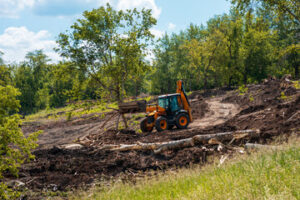Land Clearing Georgetown improves the accessibility of your property and helps prevent accidents caused by tripping or falling branches. It also makes the area more visually appealing and increases its value.

Dense areas are the favorite spots of pests like mosquitoes and rodents, particularly during rainy seasons when they can find shelter there. Land clearing eliminates the hiding places of these pests and controls their population.
Many land clearing projects require permits or clearances to ensure that they are conducted in an environmentally responsible manner. The permit process can involve submitting detailed plans and conducting environmental impact assessments. It is important to navigate these requirements carefully to avoid legal issues and delays. A professional land clearing company can help you obtain the necessary permits for your project.
Once you have obtained the necessary permits, you can begin the physical clearing process. During this phase, it is important to assess the site and determine the methods that will be used to clear the vegetation. Depending on the type of vegetation, terrain, and conditions, you may need to use different types of equipment. Choosing the right equipment will ensure that your project is completed efficiently and safely.
Land clearing can be a complicated and time-consuming process. Make sure to hire a certified and experienced professional to handle the job. They can offer you a cost-effective service and guarantee an effective result while maintaining the integrity of the surrounding ecosystems.
Before beginning the clearing process, it is important to check with local officials to see if your property has any environmental or zoning protections. If the land is protected, it is best to fence or mark off the area so that it does not get disturbed. Also, be sure to check if the area is a high erosion risk or has water supply watersheds.
Manual Clearing
Land clearing is a necessary step for many projects, including construction of homes or commercial buildings and agriculture. It also helps prevent wildfires by reducing the amount of combustible vegetation on the ground. The process involves removing trees, shrubs, stumps and other vegetation to create a level surface for building or farming.
There are different methods for clearing land, with some using heavy machinery and others relying on manual labor. The best method depends on the type of land and its intended use, with some methods having a larger environmental impact than others. For example, controlled burning can have negative effects on air quality and wildlife habitats.
For large-scale projects, mechanical clearing uses machines like bulldozers and mulchers for efficiency and precision. It’s also ideal for areas with dense vegetation or steep slopes. However, it’s important to use a professional with experience and the right equipment to avoid accidents and property damage.
For smaller jobs, such as taming overgrowth, brush cutters and lawn mowers are popular tools. They can help clear away grasses, weeds and vines easily. Some even come with towable kits, making it easy to move them around the property for quick and efficient cleanup.
Mechanical Clearing
If you have a small plot of land that needs to be cleared, it may be easier for you to do the work yourself with tools like chainsaws and stump grinders. However, for larger projects with thick undergrowth or rocky terrain, it’s typically in your best interest to hire a professional. They’ll be able to handle the clearing process more efficiently and safely, which will save you time and money in the long run.
In addition to removing vegetation and obstacles, clearing land also involves removing any debris from the site. This ensures that construction and other projects can take place without being hindered by any unnecessary obstacles. It also helps reduce safety hazards and create a more visually appealing landscape for the site.
Mechanical clearing uses heavy machinery such as bulldozers and excavators to remove overgrowth quickly. It’s efficient for large-scale projects but requires skilled operators to avoid environmental damage. Chemical clearing uses herbicides to kill unwanted vegetation. It’s effective but can be dangerous for workers and animals if used incorrectly. Controlled burning, also known as prescribed burns, is a safe and efficient way to clear large areas of vegetation but requires careful planning and strict adherence to fire regulations to prevent wildfires.
The most important consideration when it comes to land clearing is making sure that the project meets local, provincial, and federal regulations. This includes obtaining the necessary permits and conducting environmental assessments. In addition, it’s crucial to balance development with environmental conservation, implementing practices that help preserve habitats and reduce carbon emissions.
Chemical Clearing
When it comes to land clearing, choosing the right technique depends on a variety of factors, including environmental considerations and the desired outcome of the project. Many different land-clearing techniques are available, including manual, mechanical, and chemical methods. Each method offers advantages and disadvantages, so it’s important to evaluate each option carefully to find the best fit for your specific needs.
Manual clearing involves the use of hand tools, such as chainsaws, to cut down trees and remove vegetation. This method is less invasive than other options, but it is also time-consuming and not suitable for large areas. Mechanical clearing uses heavy machinery, such as bulldozers and excavators, to clear larger areas more quickly. However, this method can cause damage to the soil and surrounding vegetation. Chemical clearing utilizes herbicides to kill vegetation. This is a quick and effective method, but it can have negative impacts on the environment if not used properly.
In addition to the above methods, clearing can also be accomplished by grubbing and dozing. These methods involve digging out tree stumps and debris and preparing the area for construction. However, these methods can be costly and labor-intensive, and they can also cause soil erosion and disruption of wildlife habitats.
Open burning is another land-clearing technique that requires a lot of labor and can be dangerous for animals and people. It can also sterilize the ground, making it impossible to grow anything there for some time.
Grading
Land clearing and grading are a vital step for real estate developers, home builders, and business owners that wish to turn their vision into reality. These processes lay the foundation for construction and help prevent issues with drainage systems, soil erosion, and other site-specific concerns. Choosing the right contractors with experience and a reputation for quality work is critical to success.
Once the vegetation is removed, rough land grading services are performed to prepare the site for building. This process involves shaping the land to meet specific slope, elevation, and contour requirements of the building project. Oftentimes, this involves mass excavation of the soil with machines such as bulldozers and excavators. In other cases, it may require the cutting of existing hills and valleys to create flat building pads.
Grading can be very labor intensive and expensive, especially if large areas of the property need to be leveled. This is why many sites choose to hire a professional grading contractor. This ensures that the job is done correctly and efficiently to minimize cost.
Once the grading is complete, a final inspection is conducted to make sure that all objectives have been met. In addition to ensuring that all debris has been properly disposed of, this inspection also checks for proper water drainage and implementation of erosion control measures. In addition, this inspection also makes sure that the property is ready for construction or landscaping.
Inspection
During the land clearing process, it’s important to inspect each area carefully to ensure that all structures and debris are removed. A professional land clearing company can help you with this. They can also determine whether the structures and debris are salvageable, recyclable, or toxic, as well as provide suggestions for their removal in a safe and eco-friendly manner. Moreover, they can also assist you in obtaining the necessary permits and complying with zoning laws and safety requirements for your development project.
The inspection process also includes assessing the site’s topography and soil conditions. This helps in creating a land clearing plan that is tailored to the unique characteristics of the site. For construction projects, clearing the land prepares it for foundation work and makes it easier to lay pipes and cables. It’s also crucial in agricultural land development, as it reduces fire hazards and improves the condition of the soil for planting crops.
In addition, it reduces the risk of pest infestation by removing potential hiding places and improving drainage. It can also minimize erosion by removing overgrown vegetation and implementing erosion control measures, such as silt fences and sediment traps. Lastly, it can also promote grass and plant growth by mulching and seeding the cleared site. After all these steps, the final inspection is conducted to ensure that the site is ready for construction or other uses.

